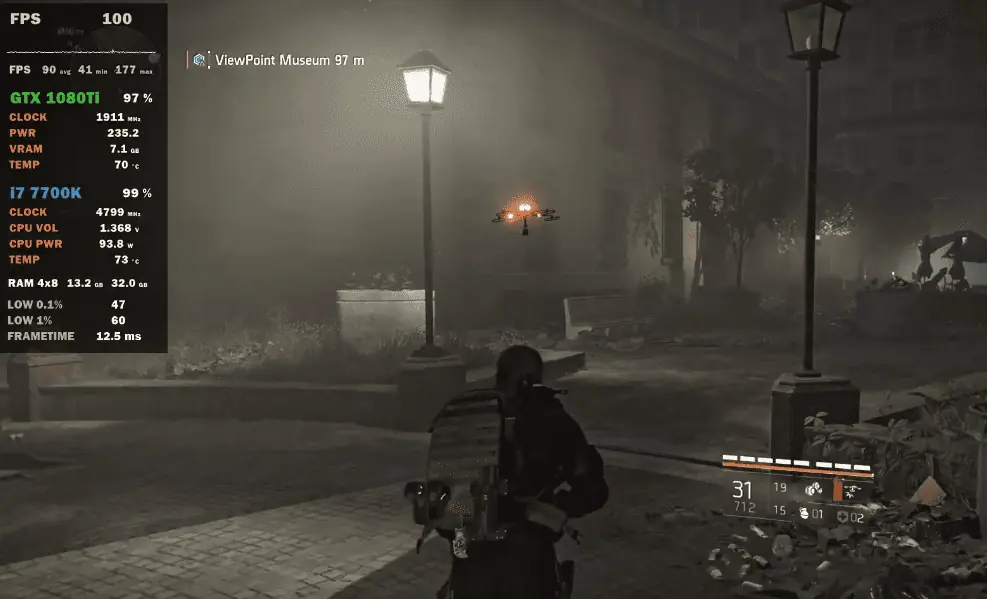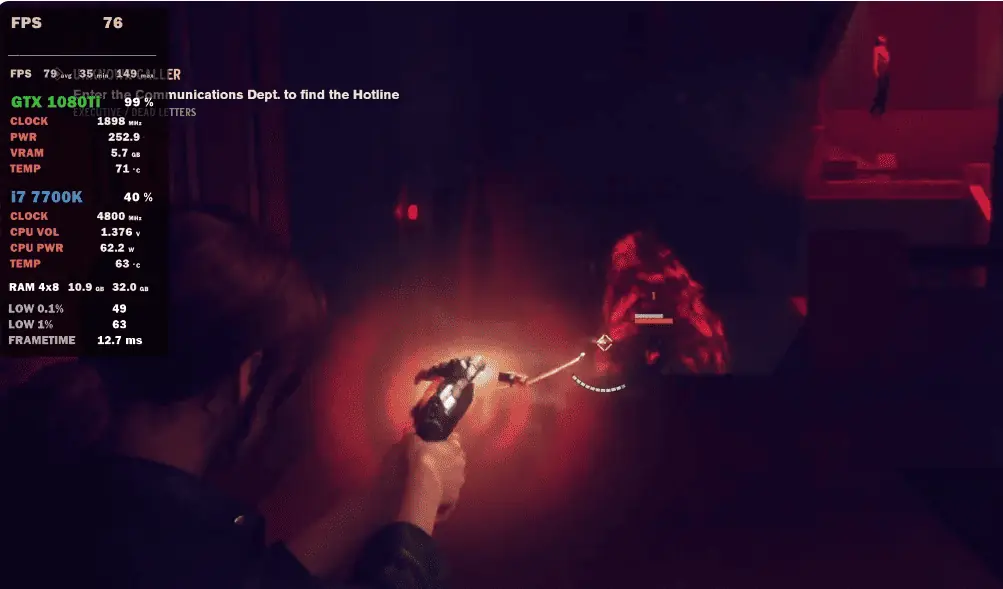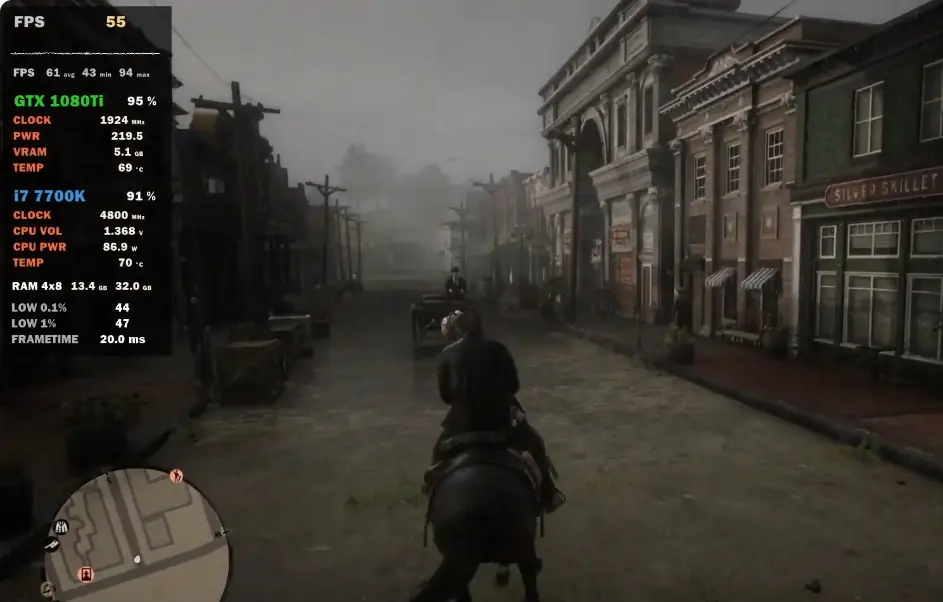For the Core i7 7700. Today, the evaluation of its upgraded version, the Core i7-7700K, will be shared. Its single-core and multi-core performance is approximately 10% higher than the former.
In the previous review, paired with the GeForce RTX 3070, the entire setup smoothly ran mainstream games without issues. However, there is a significant limitation: the Core i7-7700 cannot fully leverage the performance of the GeForce RTX 3070, reaching a maximum GPU usage of only about 80%.

For the Core i7-7700K in this test, the partner chosen was the GeForce GTX 1080 Ti. There’s no need to elaborate much on the capabilities of this older card. In the Time Spy Extreme test, the GeForce GTX 1080 Ti scored only about 500 points lower than the GeForce RTX 4060, essentially performing on par.
There are two key considerations: First, whether the Core i7-7700K can fully utilize the performance of the GeForce GTX 1080 Ti. Second, what the final actual gaming performance of this setup is, and how long it can continue to perform well? This information is valuable for those currently using older configurations who may be considering upgrading with second-hand components.
01
Parameter Review with Core i7 7700K & GTX 1080 Ti
The Core i7-7700K was released on January 3, 2017, using a 14-nanometer process, featuring 4 cores and 8 threads, with a base operating frequency of 3.6 GHz, a maximum operating frequency of 4.2 GHz, equipped with 8MB of smart cache, a standard power consumption of 65W, and a suggested retail price of 303 US dollars.

The GeForce GTX 1080 Ti was released on March 10, 2017, using the GP102 GPU, based on the Pascal architecture, with TSMC’s 16-nanometer process, containing 3584 CUDA cores, 224 texture units, 88 raster units, 28 multi-unit streaming processors, and an L2 cache of 2.75MB.
- The Standard Operating Frequency: 1481MHz
- Maximum Operating Frequency: 1572 MHz
- Memory: 11GB of GDDR5X
- Memory Speed: 11Gbps
- Memory Bus width: 352 bits
- Memory Bandwidth: 484.4GB/s
- FP32 performance: 11.34 TFLOPS
- Power Consumption: 250W
- The official suggested retail price: 699USdollars.
02
Test Platform Configuration
The main configuration is as follows:
- Processor: Core i7-7700K
- Memory: 32GB DDR4
- Graphics Card: GeForce GTX 1080 Ti
- Operating System: Windows 11
03
Game Test
The following seven games will be tested, all using 1080P quality mode.
① The First Game is ‘Tom Clancy’s The Division 2’

- Average Frame Rate: 100 FPS
- Minimum Instantaneous Frame Rate: 60 FPS
- Frame Time: 12.5ms
- CPU usage: 99%
- Power Consumption: 94W
- CPU temperature: 73 degrees
- Memory usage: 13.2GB
- GPU usage: 97%
- Video Memory usage: 7.1GB
- Power Consumption: 235W
- GPU Temperature: 70 degrees
In this game, the performance of the Core i7-7700K is nearly maximized, with memory usage exceeding 13GB. The GPU usage reaches 97%, slightly below its maximum capacity, with video memory usage around 7GB.
Regarding the average frame rate, it reaches approximately 100 FPS, while the minimum instantaneous frame rate hovers around 60 FPS. The frame time is around 12ms, showcasing consistent performance. Apart from the high resource usage, there are no issues observed.
② The Second Game is ‘Forza Horizon 4’

- Average Frame Rate: 126 FPS
- Minimum Instantaneous Frame Rate: 10 FPS
- Frame Time: 8.0ms
- CPU usage: 68%
- Power Consumption: 80W
- CPU temperature: 70 degrees
- Memory usage: 10.3GB
- GPU usage: 84%
- Video Memory usage: 4.5GB
- Power Consumption: 162W
- GPU Temperature: 64 degrees
In this game, the Core i7-7700K usage remains under 70%, with memory usage around 10GB, GPU usage at 84%, and video memory usage below 5GB. Various performance indicators are notably lower compared to the previous game, and relatively lighter in demand.
Regarding the average frame rate, it surpasses 120 FPS. However, the minimum instantaneous frame rate performance is poor, with a frame time of around 8ms. Overall performance is very good, but stability is subpar.
③ The Third Game is ‘Resident Evil 3’

- Average Frame Rate: 182 FPS
- Minimum Instantaneous Frame Rate: 3 FPS
- Frame Time: 7.4ms
- CPU usage: 60%
- Power Consumption: 74W
- CPU temperature: 71 degrees
- Memory usage: 8.5GB
- GPU usage: 80%
- Video Memory usage: 6.6GB
- Power Consumption: 167W
- GPU Temperature: 68 degrees
In this game, the Core i7-7700K utilization is only at 60%, relatively relaxed. Memory usage is below 9GB, GPU usage is at 80%, and video memory usage is below 7GB, indicating a relatively lightweight demand.
Regarding the average frame rate, it reaches around 180 FPS. However, the minimum instantaneous frame rate performance is poor, with a frame time of around 7ms. Overall, the performance is very good.
④ The Fourth Game is ‘Control’

- Average Frame Rate: 76 FPS
- Minimum Instantaneous Frame Rate: 63 FPS
- Frame Time: 12.7ms
- CPU usage: 40%
- Power Consumption: 62W
- CPU temperature: 63 degrees
- Memory usage: 10.9GB
- GPU usage: 99%
- Video Memory usage: 5.7GB
- Power Consumption: 253W
- GPU Temperature: 71 degrees
In this game, the Core i7-7700K usage is only 40%, very relaxed. Memory usage is around 11GB, and the GPU usage finally reaches its maximum at 99%, with video memory usage below 6GB.
Regarding the average frame rate, it runs at over 70 FPS, with the minimum instantaneous frame rate also above 60 FPS. The frame time is around 13ms, showcasing overall very stable performance.
⑤ The fifth game is ‘Red Dead Redemption 2’

- Average Frame Rate: 55 FPS
- Minimum Instantaneous Frame Rate: 47 FPS
- Frame Time: 20.0ms
- CPU usage: 91%
- Power Consumption: 87W
- CPU temperature: 70 degrees
- Memory usage: 13.4GB
- GPU usage: 95%
- Video Memory usage: 5.1GB
- Power Consumption: 220W
- GPU Temperature: 69 degrees
In this game, the Core i7-7700K’s CPU usage reaches 91%, memory usage exceeds 13GB, and GPU usage is at 95%, with video memory usage around 5GB, indicating substantial resource consumption.
Regarding the average frame rate, it runs at over 50 FPS, with the minimum instantaneous frame rate above 40 FPS. However, the frame time reaches around 20ms, resulting in higher latency. Despite this, smooth gameplay remains unaffected.
⑥ The Sixth Game is ‘Dead Space’

- Average Frame Rate: 70 FPS
- Minimum Instantaneous Frame Rate: 43 FPS
- Frame Time: 13.6ms
- CPU usage: 66%
- Power Consumption: 84W
- CPU temperature: 74 degrees
- Memory usage: 10.0GB
- GPU usage: 100%
- Video Memory usage: 6.3GB
- Power Consumption: 204W
- GPU Temperature: 68 degrees
In this game, the Core i7-7700K’s CPU usage is at 66%, nearly two-thirds of its capacity. Memory usage is around 10GB, and the GPU usage reaches 100%, fully utilized, with video memory usage slightly over 6GB.
Regarding the average frame rate, it reaches around 70 FPS, with the minimum instantaneous frame rate above 40 FPS. The frame time is around 14ms, showcasing overall stable performance.
⑦ The Seventh Game is ‘Hogwarts Legacy’

- Average Frame Rate: 66 FPS
- Minimum Instantaneous Frame Rate: 40 FPS
- Frame Time: 12.1ms
- CPU usage: 60%
- Power Consumption: Not Provided
- CPU temperature: 64 degrees
- Memory usage: 20GB
- GPU usage: 98%
- Video Memory usage: 7.3GB
- Power Consumption: 220W
- GPU Temperature: 68 degrees
In this game, the Core i7-7700K’s CPU usage remains at 60%, with memory usage approaching 20GB. The GPU usage is at 98%, nearly maxed out, with video memory usage exceeding 7GB. Overall, this game consumes substantial memory and graphics card performance.
Regarding the average frame rate, it maintains above 60 FPS, with the minimum instantaneous frame rate around 40 FPS. The frame time is approximately 12ms, showcasing a consistently stable performance.
04
Test Conclusion
Among the seven games tested, five games exhibited a GPU usage rate of over 90%, while the remaining games had relatively lighter usage, below 90%, which is considered normal. This indicates that pairing the Core i7-7700K with the GeForce GTX 1080 Ti essentially eliminates bottlenecks and allows the graphics card to perform at its maximum potential.
Overall, the performance of this configuration is decent. If the requirements are not too demanding, it can still be viable for another couple of years. However, it’s worth noting that the GeForce GTX 1080 Ti does have a relatively high power consumption, exceeding 200W in several games, whereas the GeForce RTX 4060 operates at a maximum of 115W under full load.

This article is the original author’s work. The views expressed in the article are their own. We only repost it to facilitate sharing and discussion, and we do not necessarily endorse or agree with it. If you have any complaints, please reach out to us via the available channels.



